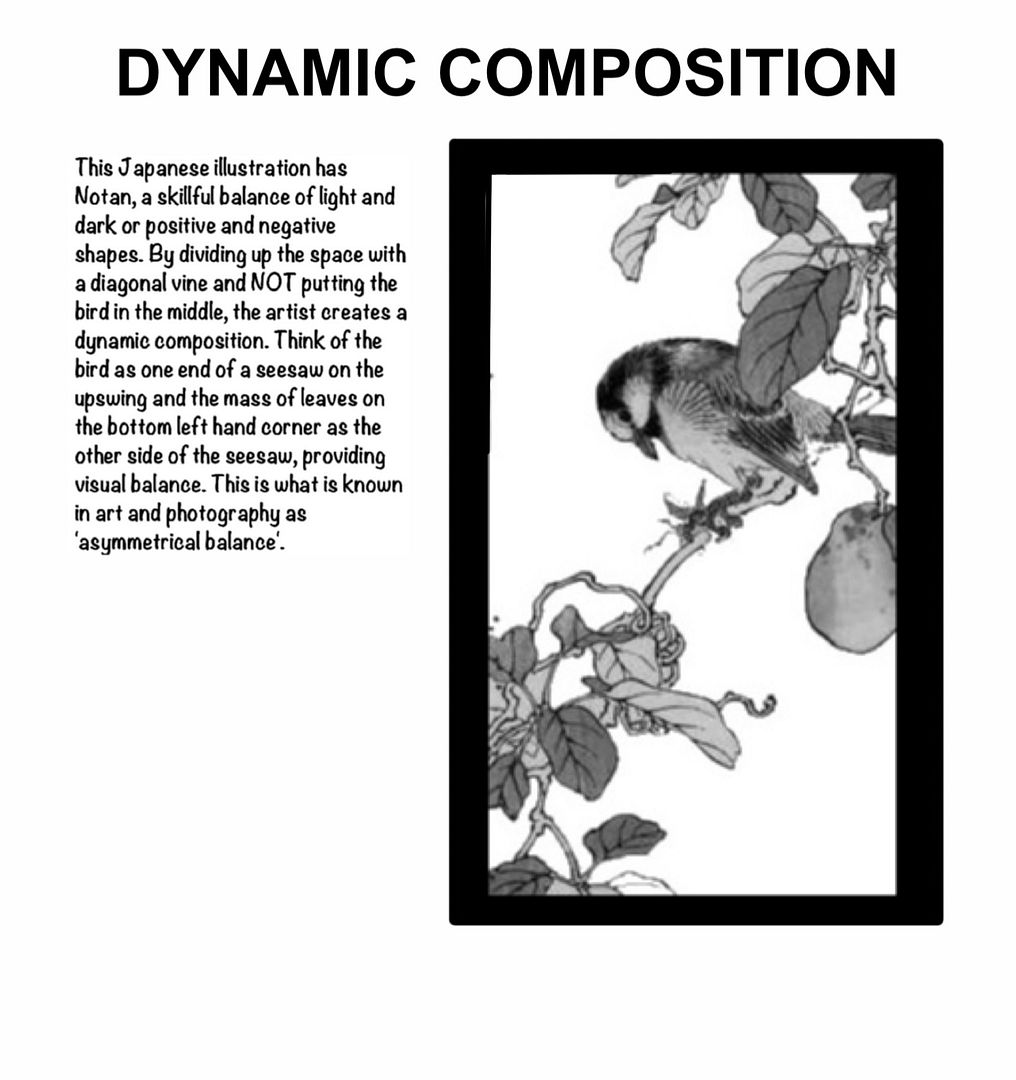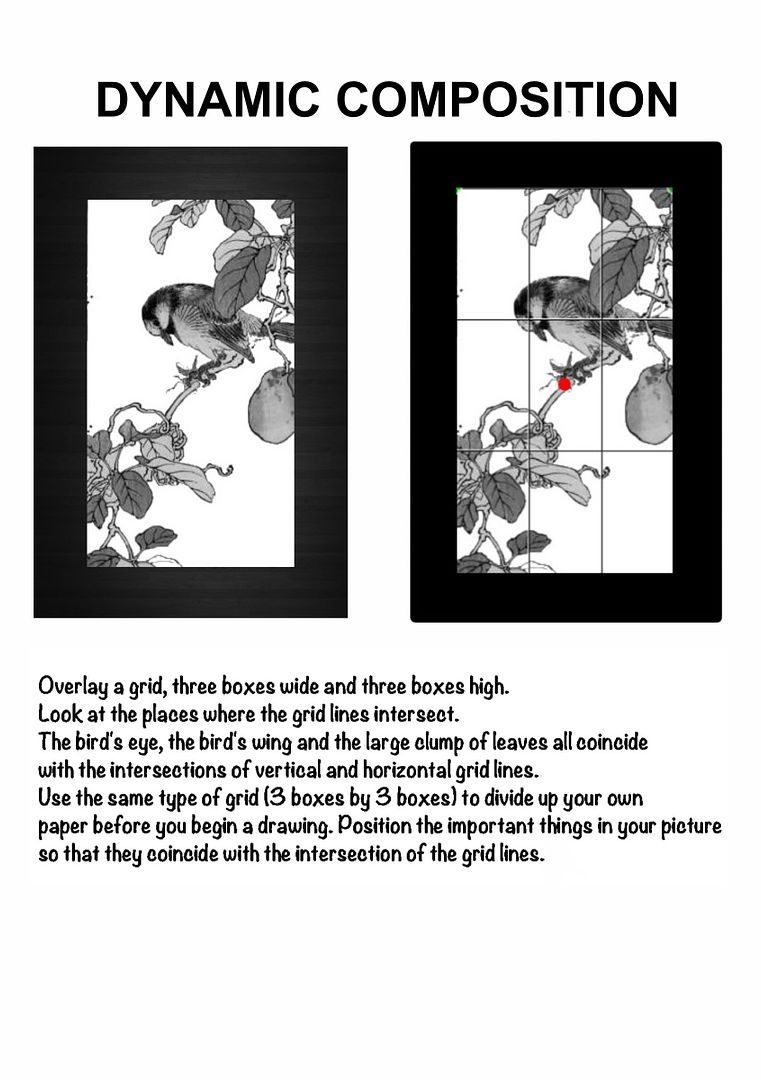Your art teacher tells you to 'fill the page'. How? With what? Here is a trick that many artists, throughout history and around the world, have used. I hope you find it helpful.
 |
Jean Baptiste Camille Corot (July 17, 1796 – February 22, 1875)
View of St. Peter’s and the Castel Saint ‘Angelo
|
The dominant form is the mass of buildings on the left.
The sub-dominant form is the round building
on the right.
St. Peter’s Basilica, the domed building, just to the left of the center of the picture, is the subordinate form and the focal point of the picture.
Put the dominant form off to one side, never in the middle. Balance it with the smaller, sub-dominant form and then balance that with even smaller subordinate form.
The subordinate form is often (but not always) the focal point of the picture. Your eye travels from form to form and finally rests on the subordinate form (or focal point). If there are roads or paths in the composition they should lead your eye to the focal point.
Here is a study of St. Peter’s from Corot’s sketchbook. Corot made many such quick compositional studies when he visited Rome. He made the final painting at a later date when he got back home to his studio in France. Before the invention of the camera artists like Corot relied entirely on sketches and memory to create their finished paintings.


Assignment:
See how many ways you can balance these landscape elements. Fold your paper to create four boxes. In each box select a different landscape element
to be your dominant form.
Then select a different
sub-dominant form to balance it and a third, subordinate form for your focal point. Your eye should travel around the page from dominant
to sub-dominant form and naturally rest on the focal point of the painting.
Remember this is just one technique
that artists use to create
dynamic compositions.
Each of these artists knew how to balance landscape elements of varying size to create dynamic compositions but not a single one of them used this trick all the time.
If you ever get confused about how asymmetrical balance is used in art, just envision that you are building a sculpture by stacking pieces of furniture on top of one another. The easiest, most obvious way to do it would be to put the largest pieces on the bottom and create a symmetrically balanced pyramid form. But what if you could figure out a way to balance and counter balance each piece of furniture so that your sculpture could stand up without being symmetrical? You could create something exciting with a sense of tension and dynamic movement. It is easy to see that the furniture on the left is balanced but how can you tell that the chairs on the right are balanced, even though the design is not symmetrical? If the chairs did not have just the right asymmetrical balance, the entire sculpture would crash to the ground. It is not so simple to determine asymmetrical balance with a picture. The composition should allow the viewers eye to travel comfortably around the page.
|


Use the 'rule of thirds' (also sometimes referred to as the 'rule of three')to create dynamic photographs and paintings. Worksheet created by The Helpful Art Teacher, 2013, using a Japanese woodblock print book illustration from the Metropolitan Museum of Art's digital library
Here is a higher resolution image of the illustration.
Try printing it and adding your own grid lines.
Analyze printouts of your favorite paintings to see which ones follow the 'rule of thirds' and which do not.
Print out low resolution black and white versions of famous pictures and draw your grid directly on the image. Make absolutely sure the image you are using has not been cropped!















awesome pics
ReplyDeleteAma-za-zing
ReplyDeleteLesson was simple, flexible and a surprising reminder of how to look for a composition in life without just accepting what's out there. The number of examples presented and their variety are a challenge for the artist who might have thought of himself as just being like a camera and literally copy the world. Art has a personal view of life, it interprets what is out there through the mind of the artist as well as his hands and skills!
ReplyDeleteIt is Very Great!!!!
ReplyDeleteIt's very useful article, thank you for sharing it with us
ReplyDeletethis is the first time i visit your site but i will be one of your permanent visitors
ReplyDelete<3 I love this.
ReplyDeleteThanks a lot =)
ReplyDeleteThis has really enhanced my thinking of the division of the frame by light years! Can you eloborate on how positive and negative space can also have dominant, subdominant, and subordinate divisions -- even within the same picture plane? Also, it seems like it is OK if two dominant, subdominant, and subordinate divisions overlap -- like one in positive space and one in negative. Is this true?
ReplyDeleteWohh precisely what I was looking for, appreciate it for posting.
ReplyDeleteI could not resist commenting. Very well written!
ReplyDeleteAppreciate this post. Will try it out.
ReplyDeleteHi, just wanted to tell you, I enjoyed this post. It was practical.
ReplyDeleteKeep on posting!
Thank you, this is so comprehensive and detailed
ReplyDelete